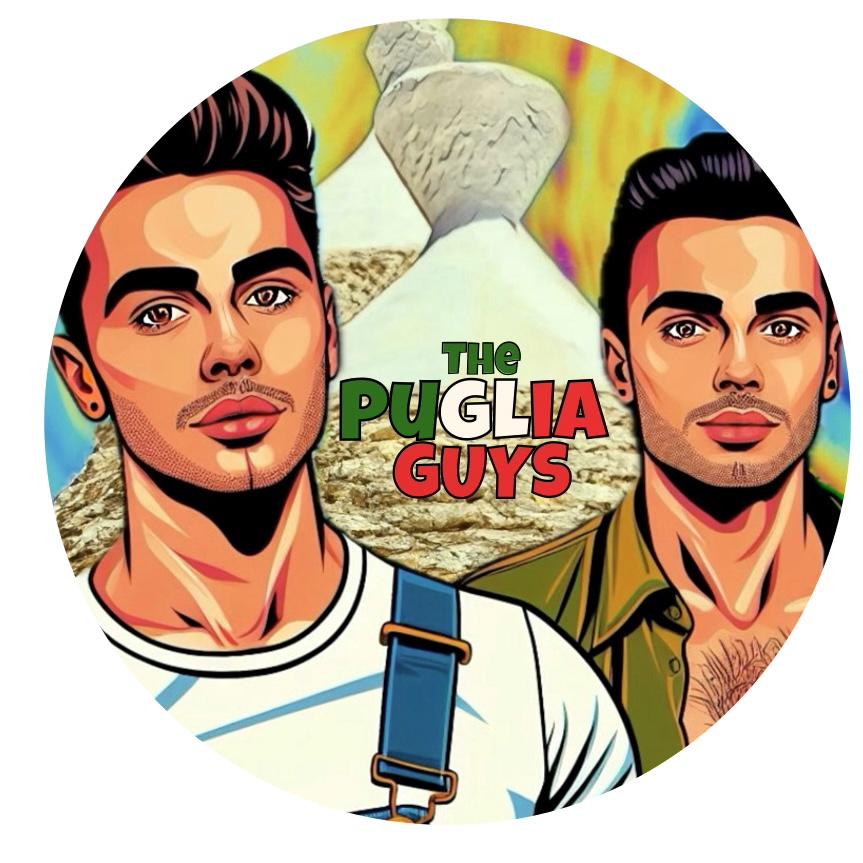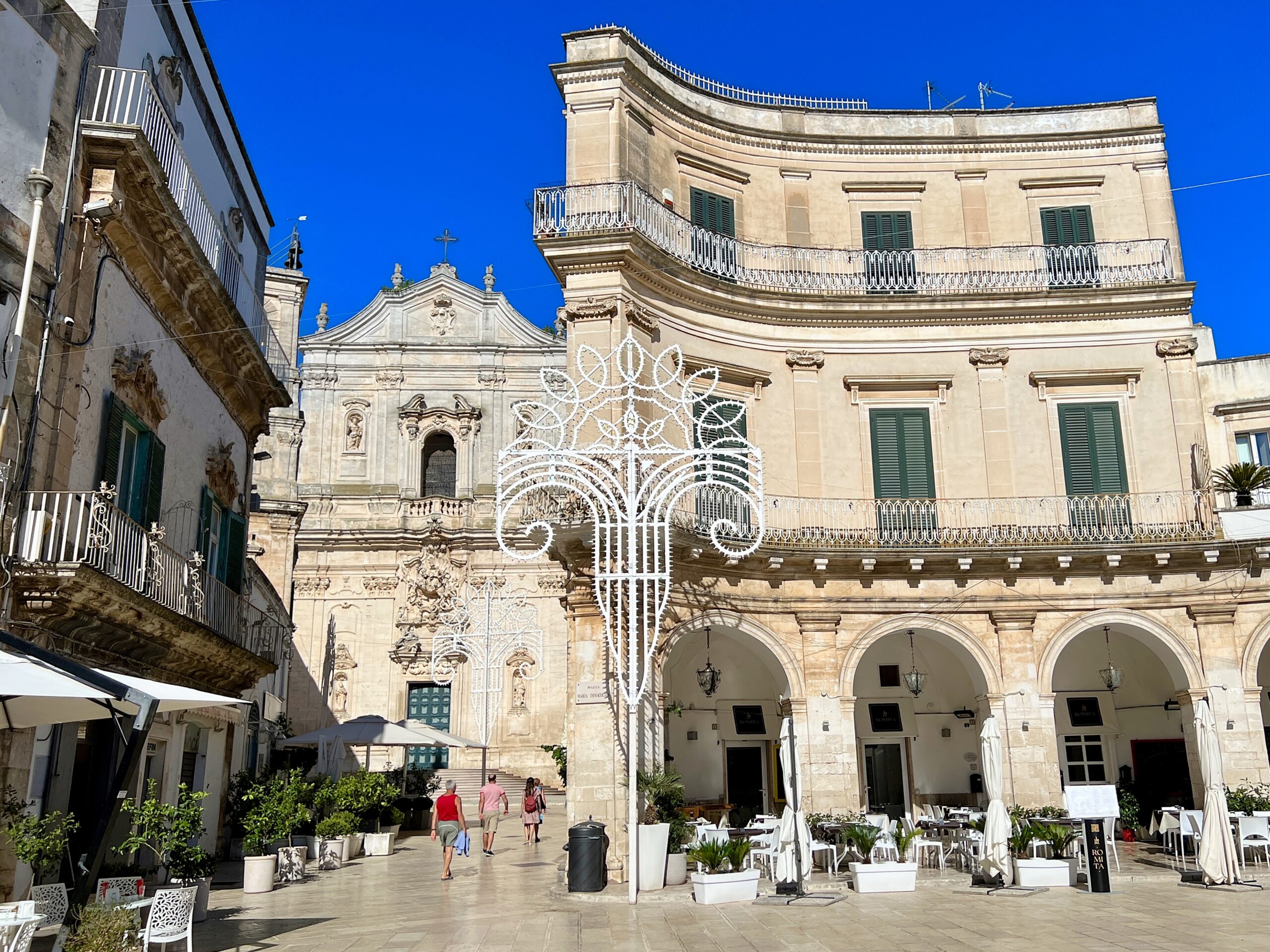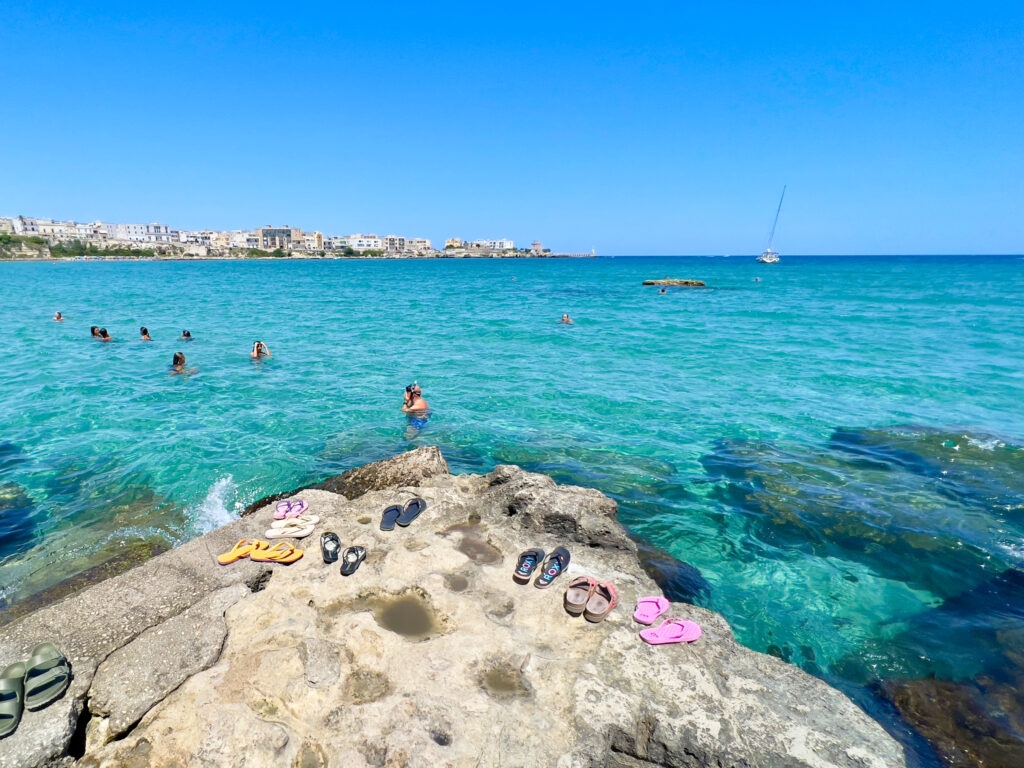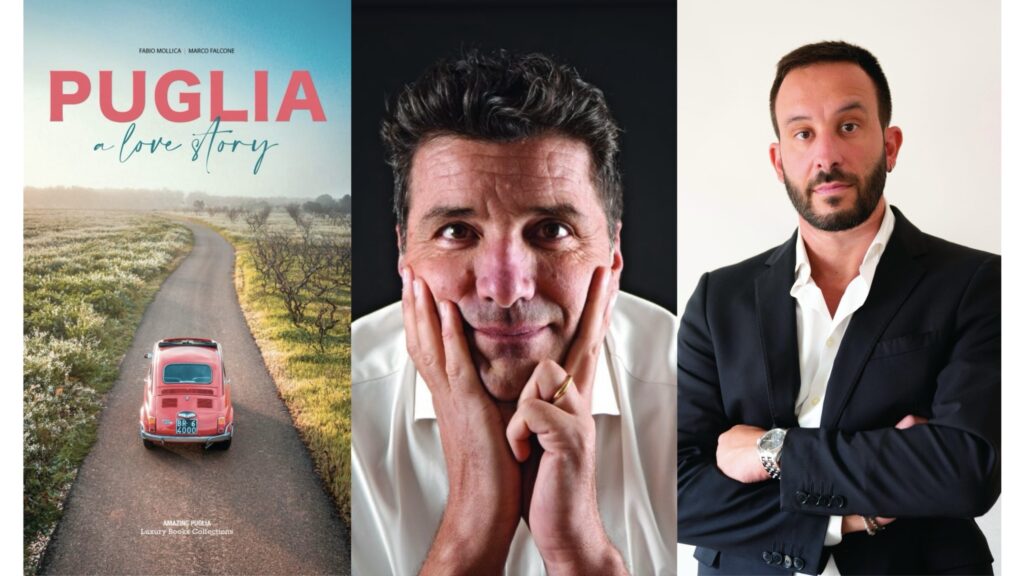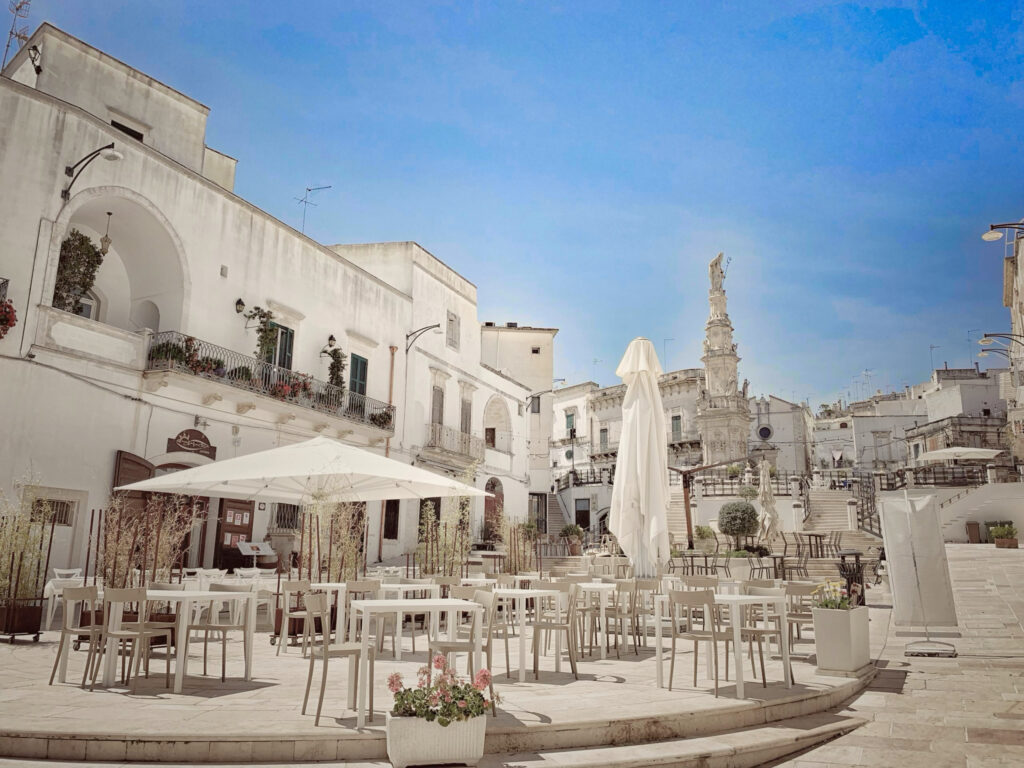Martina is a town rich in Baroque elegance, historic charm, and cultural heritage. Walking through its winding streets, visitors encounter stunning churches, grand palaces, and picturesque piazzas, each telling a story of the town’s rich past. Our Puglia Guys Martina Franca guide takes you on a journey through the most remarkable sites, from the Gothic convents to the Baroque splendour of its churches and palazzi, with recommendations for the best local restaurants to complete your experience.
Nestled in the picturesque Valle d’Itria, approximately halfway between the Ionian and Adriatic Seas, Martina Franca’s strategic position—which allowed for control over trade and commerce, a key factor in the town’s prosperity—played a crucial role in shaping its past, from ancient settlements to medieval fortifications and Baroque splendour.
For history lovers, art enthusiasts, and cultural explorers, Martina’s churches offer a glimpse into a time when faith and art were inextricably linked, creating monuments that continue to inspire and captivate.
Today, Martina Franca is a vibrant town, the largest of the Valle d’Itria. Its charm lies in its baroque architecture, splendid churches, the narrow streets of its old town, and 18th-century town houses with Baroque features and wrought-iron balconies. Known for its gastronomy (we recommend some of our favourite restaurants, but in reality there is no need to adhere to them as good food is easy to find – so if somewhere else takes your fancy, go for it), Martina’s best known culinary export capocollo di Martina Franca (our favourite regional cured meat).
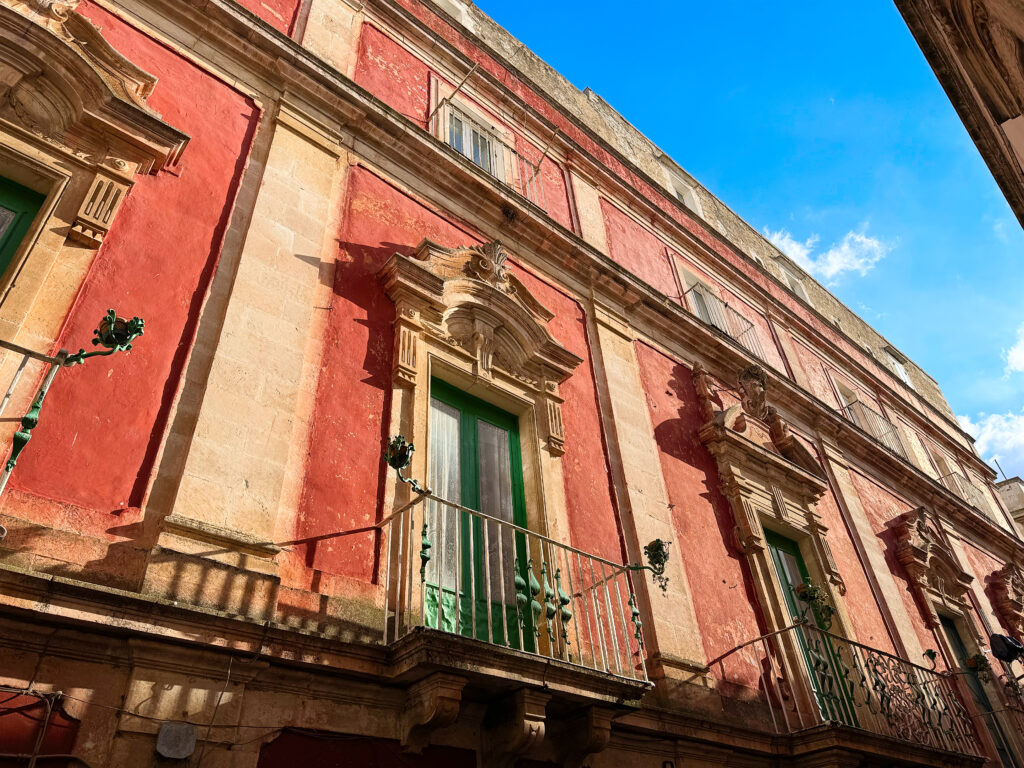
The Puglia Podcast | Martina Franca Guide
Also available on Apple Podcasts and Spotify, or wherever you get your podcasts from.
We don’t accept payments or freebies for positive coverage or recommendations. Our reviews are anonymous to ensure we have the same experience as any visitor.
Follow us on Instagram for frequent video stories, reels, photos, ideas and other information to inspire your visit to Puglia.
Martina Franca Guide | Food Story
Martina is one of Puglia’s ”foodie” destinations. It serves up the whole range of traditional Puglia cuisine, but is best known for its cured meats and bombette.
Capocollo di Martina Franca is a speciality of the region since the 18th century. Cut from pork shoulder (running from the neck to the fourth or fifth rib), capocollo di Martina Franca is a sweet, delicately cured ham. It is prepared by being rubbed with salt, pepper and spices and left for 15 days. Then it has a marinade bath in herbs and vin cotto and left for a fortnight or so before being smoked with oak bark chippings, almond husks and more Mediterranean herbs. Finally it is hung to cure for at least another three months.
Bombette Pugliesi originate from nearby Cisternino, but are easy to find in Martina. Bite size parcels of meat, usually pork, filled with cheese, vegetables or other cured meats and grilled over an open fire or in a traditional clay oven.
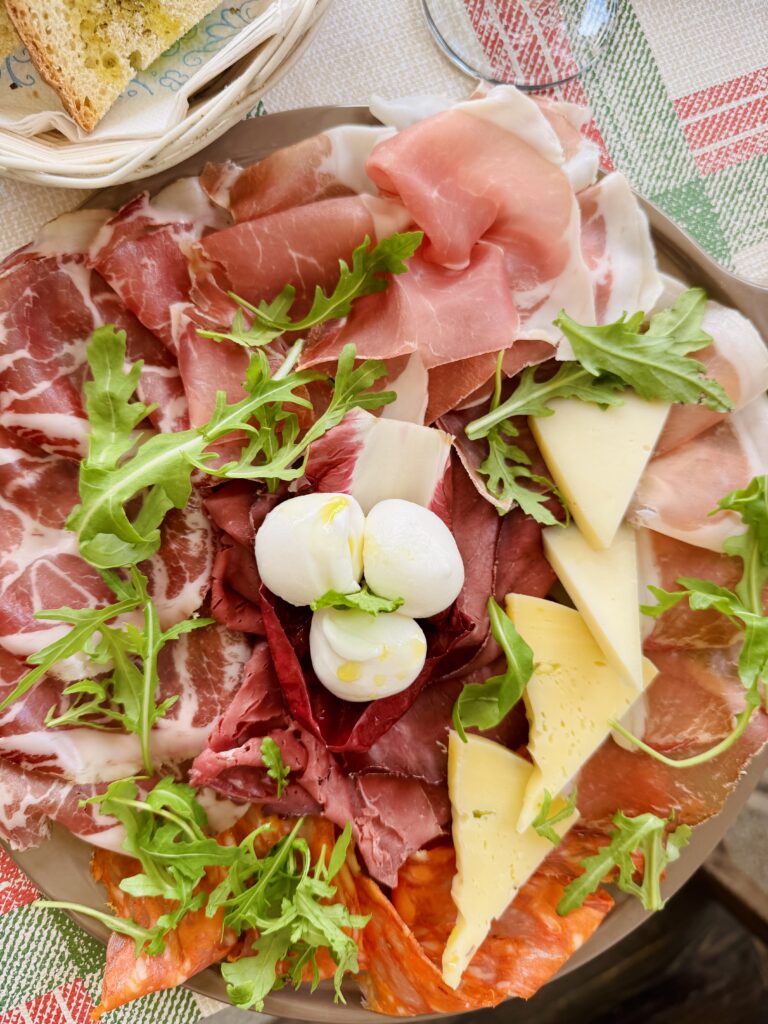
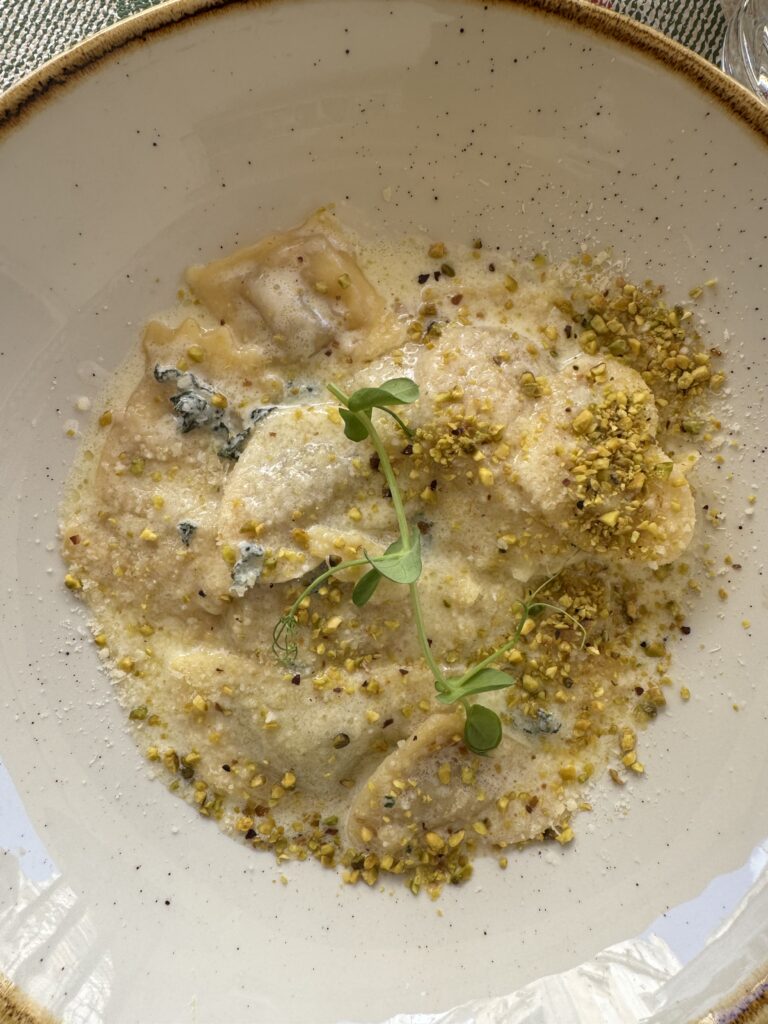
Martina Franca Guide | Getting there
By car only a short hop across the Valle d’Itria from Alberobello, Locorotondo, Cisternino, Ostuni and Ceglie.
By public transport Martina is still accessible, but not as convenient. There are frequent trains (Ferrovie del Sud Est – FSE) from Bari, but the journey time is 1h50m. However from Taranto the train journey only takes 40 minutes. There are frequent trains connecting Alberobello and Martina, a 14-minutes journey.
Bus services on Sundays!
Martina Franca Guide | From Prehistory to Post War
Ancient Settlements and Early Inhabitants
Martina Franca’s history can be traced back to the Neolithic period. Archaeological discoveries in the surrounding karst caves at Gravina del Vuolo, Gravina delle Voccole, Grotta della Breccia, Grotta Parco della Vigna, and Grotta di Monte Fellone reveal the presence of small communities of hunters and herders.
Archaeological findings in the region are scarce. Surface surveys and historical sources suggest that settlements existed from the 8th century BC to the 10th century AD. Artefacts from the 6th century BCE suggest the presence of summer holiday homes for the citizens of Taranto, during the Magna Graecia period and later Roman rule.
One of the most significant archaeological sites is Masseria Badessa Vecchia, formerly known as Sisignano, where excavations have revealed continuous human occupation from the Bronze Age to the Early Middle Ages. Here, a fortified indigenous village with defensive walls was strategically located along the Isthmian Way, an ancient route connecting Taranto to Egnazia.
Following the destruction of Taranto by the Saracens in the 10th century, survivors fled to seek refuge in the Murgia highlands, swelling the population of its rural settlements.
Medieval Foundations and the Birth of a Free Town
The earliest documented reference to a medieval settlement in the area appears in the Instrumentum executionis mandati regii from 1260. This document records the Castrum Martinae, a military installation likely consisting of a tower with basic fortifications, standing on a hill overlooking the Valle d’Itria.
The official foundation of Martina Franca dates back to 1310 when Philip I of Anjou, Prince of Taranto, ordered the foundation of the fortified town of Martina to encourage settlement in the region. Scholars debate whether the town emerged from the consolidation of four existing rural hamlets—Montedoro, San Martino, Santa Teresa, and San Pietro dei Greci which, once enclosed by walls and towers, formed the town named after the largest settlement, San Martino—or if the Angevins incentivised scattered inhabitants of the Murgia forests to relocate to a fortified urban centre.
To attract settlers, Philip I granted Casale della Franca Martina special privileges, including tax exemptions and free grazing rights. The name Franca (meaning “free” or “exempt”) reflects these benefits, distinguishing it as a town where residents were not burdened by feudal levies. By 1317, a defined territory of 4,278 hectares was established, ensuring landowners could graze livestock, access water, collect wood, harvest acorns and build homes without paying feudal dues.
Through the right of parietare (the ability to enclose and claim land), individuals could become landowners of the plots they cultivated, thus promoting small scale farming and agriculture.
Expansion and Feudal Control
In 1359, Prince Robert of Anjou-Taranto further expanded the town’s territory, incorporating lands from Monopoli, Ostuni, Mottola and Ceglie Messapica. By 1374, Martina was officially recorded as Terra di Martina, a walled town with defensive towers and four gates.
The urban core of Martina Franca that developed in the 14th century roughly corresponds to today’s historic centre, remnants of which still exist.
However, in 1507, the town’s fate changed when, following his war with Charles VIII of France, Ferdinand of Aragon sold Martina to Petracone III Caracciolo for 6,000 ducats, conferring upon him the title of Duke of Martina. Under feudal rule, the town’s fortunes fluctuated, yet it remained a centre of agricultural and pastoral wealth.
The Rise of the Masseria and Economic Growth
The region’s landscape, with its fertile soil and natural pastures, favoured livestock breeding. Initially focused on goat herding, Martina Franca became renowned for its selective breeding of large-horned cattle (Podolica Pugliese) and equines, such as the Cavallo delle Murge and the Asino di Martina. Raised semi-wild, these were animals valued for their strength, resistance to cold, and ability to thrive with limited water.
This agricultural prosperity led to the rise of the masseria system—large, self-sufficient, enclosed farm estates characterised by dry-stone walls, stables, hay barns, and chapels. Between the 16th and 19th centuries, over 250 masserie dotted the countryside, many adorned with exquisite frescoes and religious iconography.
A Tax On All Your Houses | Feudal Oppression and Revolt
Despite its economic success, Martina Franca suffered under the heavy-handed rule of Francesco I Caracciolo in the early 17th century. By confiscating and monopolising the town’s mills, and enforcing strict taxation the 7th Duke of Martina sparked widespread discontent. Inspired by the Masaniello revolt in Naples (1647), Martina’s citizens rebelled in 1648, seizing the town during Francesco’s absence (suppressing another revolt in Taranto). However, fearing the Duke’s retribution following news of his brutal repression in Taranto, the rebels eventually fled.
The failed revolt resulted in harsher taxation.
Cultural Transformation and Baroque Transformation
Martina Franca’s golden age began in the late 17th century under Duke Petracone V Caracciolo (1655-1704). Using his wealth, he commissioned the grand Palazzo Ducale in 1668, built on the ruins of a medieval castle. This opulent palace, long attributed to Bernini but now believed to be the work of architect Giovanni Andrea Carducci, symbolised the feudal elite’s power and set the stage for the town’s Baroque transformation.
Throughout the 18th century, Martina Franca flourished artistically and architecturally. Neapolitan Baroque influences shaped the town, leading to the construction of the Chiesa del Carmine, the Basilica di San Martino, and the Chiesa di San Domenico. Wealthy families commissioned elaborate palaces, while skilled local stonemasons adorned even modest homes with intricate decorations. The artistic vibrancy extended to painting, with notable artists such as Olivieri, the Carellas, and De Mauro contributing to the town’s cultural heritage.
The End of Feudalism and Modern Developments
Feudalism was abolished in 1806 under French rule, restoring Martina Franca’s municipal autonomy. The town’s defensive walls were dismantled in 1861, allowing for urban expansion. However, the rapid and unregulated growth of the post-war period resulted in a modern cityscape that lacks the charm of its historic centre.
Meanwhile, agricultural practices evolved. Traditional livestock farming gave way to viticulture, with Martina Franca’s wines becoming highly sought after for blending.
Martina Franca Guide | A Walking Tour Around The Old Town
Walking through Martina’s winding streets, you will encounter stunning churches, grand palaces, and picturesque piazzas. Our Puglia Guys Martina Franca guide takes you on a journey through its most remarkable sites, from the Gothic convents to the Baroque splendour of its churches and palazzi, with recommendations for the best local restaurants to complete your experience.
Orientation
Piazza XX Settembre is Martina’s main square, a popular meeting place leading directly into the old town. To the right of the main gate into the old town, the Porta Santo Stefano, is the tourist information office where you can pick up a map with suggested walking itineraries (and almost 60 points of interest along the way). We recommend picking one up because trying to find your way through the old town’s network of alleyways and arches using GPS and road references can be confusing!
Starting Point: Parrocchia Sant’Antonio da Padova and Villa Garibaldi
Before stepping into the old town, begin your exploration at Parrocchia Sant’Antonio da Padova and its adjacent Convent of Santa Maria delle Grazie. Built in a Gothic style, these religious structures once belonged to the Carmelite Order and today stand as testaments to the town’s spiritual history. The nearby Villa Garibaldi public gardens, once part of the convent, offer a serene spot to appreciate the town’s greenery and historic charm.
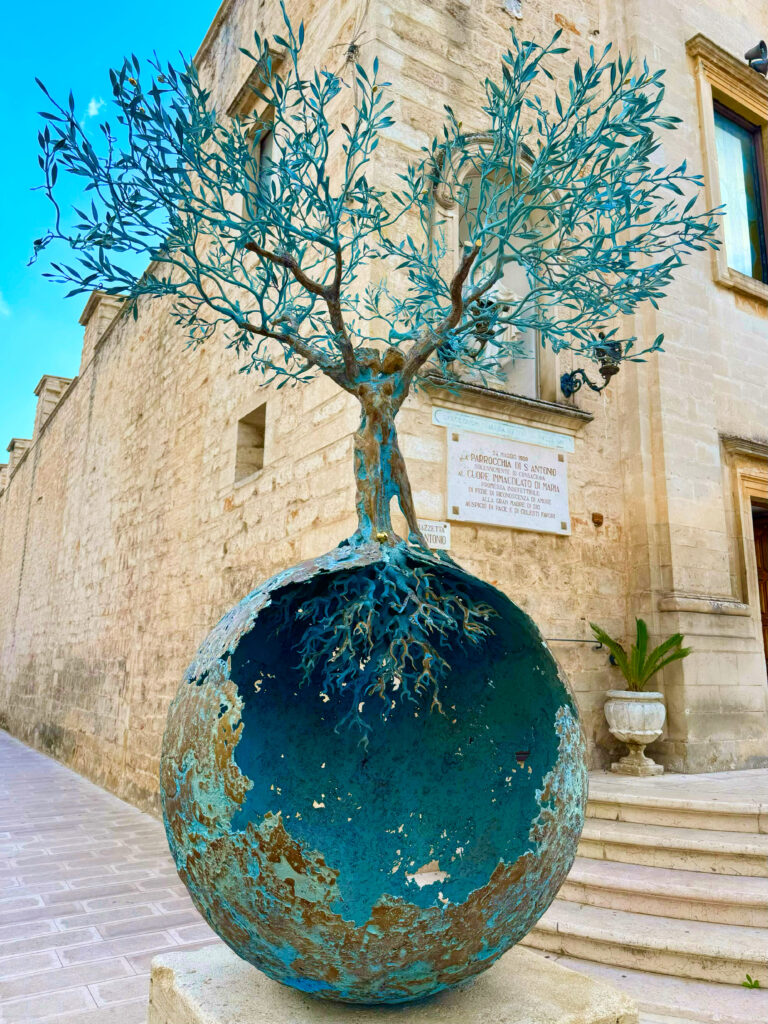
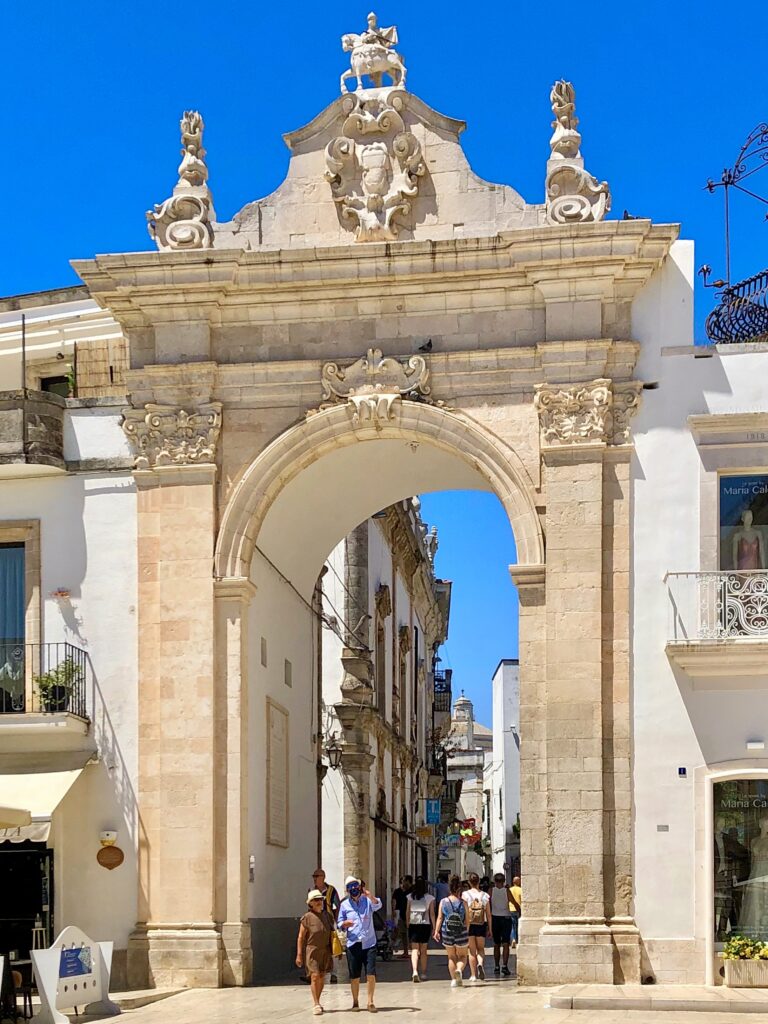
Entering the Old Town: Porta Santo Stefano
The main entrance to Martina Franca’s historic center is through Porta Santo Stefano, a triumphal arch carved out of the city walls in 1764. Atop the arch, the statue of St. Martin commemorates a miraculous event during the siege of the Cappelletti. Walking through this gateway feels like stepping back in time, as Martina’s narrow alleys and Baroque facades unfold before you.
Piazza Roma and the Grand Palazzo Ducale
As you step into Piazza Roma, you’ll be greeted by Palazzo Ducale, an imposing 17th-century palace with elegant balconies and intricate iron railings. Construction began in 1668 on the ruins of the Orsini Castle and was completed in the 18th century by Francesco III. The palace now serves as the municipal town hall, but inside, its frescoed halls and grand architecture remain open for visitors to admire.
🔍 Puglia Guys Insider Tip:
- Palazzo Ducale’s Secret Frescoes – While many admire the grand balconies and iron railings, few realise that inside, some rooms feature beautifully preserved frescoes from the 18th century, depicting mythological scenes and pastoral landscapes. The royal apartments on the piano nobile are hung with beautiful Murano glass chandeliers.
🍴 Where to Eat Nearby:
- Gran Caffè – Perfect for coffee and aperitivi, breakfast pastries and savoury panzerotti (and people watching).
- Trattoria La Tana – A rustic trattoria known for its excellent homemade pasta, bombette (stuffed meat rolls), and traditional dishes.
- Macelleria Braceria Granaldi – A butcher shop-turned-restaurant, known for grilled meats and bombette.
Piazza Plebiscito & The Basilica di San Martino
Continuing along Corso Vittorio Emanuele (known locally as Ringo, derived from arengo, meaning a meeting place), you arrive at Piazza Plebiscito, where some of Martina Franca’s most important landmarks stand:
- Basilica di San Martino (1747-1775) – A masterpiece of Baroque architecture, its Latin cross layout, marble altars, and statues of Charity and Abundance by Giuseppe Sammartino make it an unmissable highlight.
- The Clock Tower & Palazzo dell’Università – Historic buildings that once played key roles in the town’s governance.
- Chiesa di Monte Purgatorio – A small but significant church dedicated to prayers for souls in purgatory.
Inside the basilica San Martino, don’t miss The Last Supper (1804) by Carella, set in a pink onyx frame, and the baptismal font by Crescenzo Trinchese (1773).
🔍 Puglia Guys Insider Tip:
- Basilica Crypt (if accessible) – Below San Martino, some sections of the original Romanesque structure still remain, though rarely open to the public.
🍴 Where to Eat Nearby:
- La Tavernetta – Friendly family style restaurant, traditional dishes, reasonable prices and great bruschetta.
- Pane Amore e Fantasia – Thoroughly recommended trattoria with local cuisine, great fresh pasta and generous tagliere (charcuterie boards).
- Ristorante Garibaldi – A cozy spot offering some modern takes on traditional cuisine, along with a good selection of local wines.
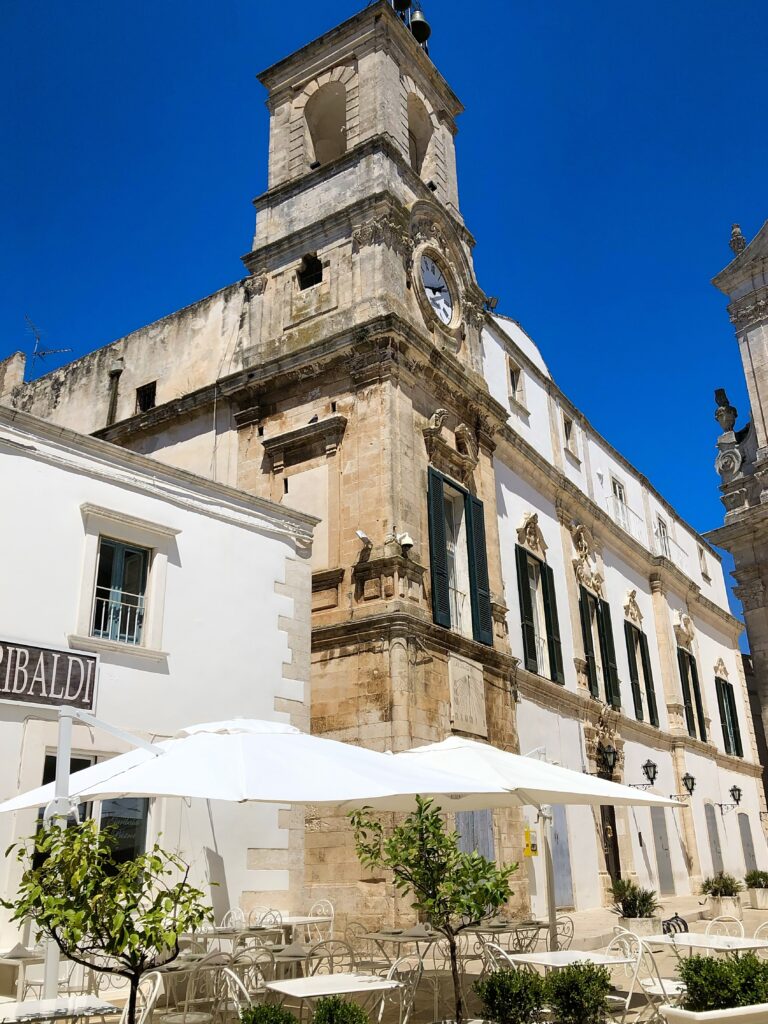
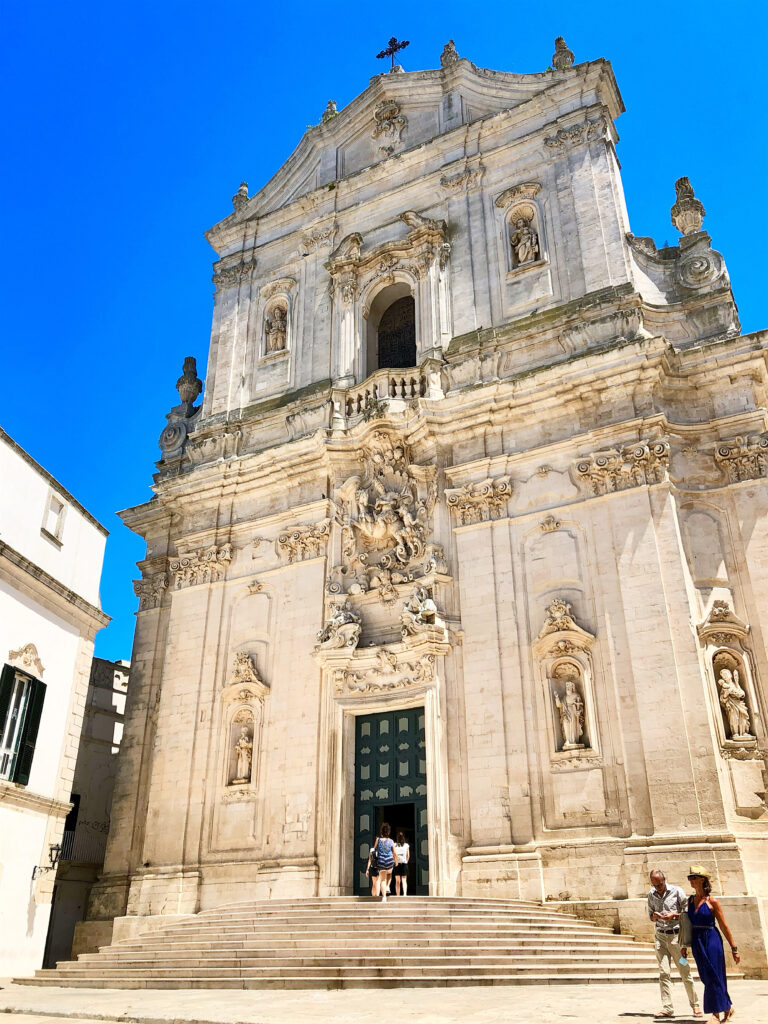
Baroque Palaces & Forgotten Alleys
Stroll through Piazza Maria Immacolata onto Via Principe Umberto, you’ll encounter Palazzo Motolese and Palazzo Grassi, both featuring grand doorways, elegant balconies, and decorative columns. The intricate gargoyle-shaped water spouts are a unique architectural touch.
Nearby, Chiesa di San Domenico (1746) dominates the street with its tall Baroque façade and elaborate window frame. Inside, look for the Madonna of the Rosary by Carella and works by Nicola Gliri.
🔍 Puglia Guys Insider Tip:
🍴 Where to Eat Nearby:
- Ristorante Four Seasons – Finer dining in stylish surroundings, but still good value.
- Ristorante Gaonas – Known for its authentic Puglia cuisine, with specialties like orecchiette pasta with cime di rapa and grilled meats.
Hidden Corners: Ospedaletto & Cordonetto District
Continuing along Via Umberto, turning left onto Via Gesù and Via Conte Ugolino. Following Via Conte Ugolino leads to Via Cappelletti and the Cordonetto district, a maze of whitewashed houses, wrought-iron balconies, and charming alleys. This area embodies the timeless beauty of Martina Franca’s old town.
You’ll pass the Ospedaletto, an 18th-century refuge for the poor, foreigners, and lepers. Its historic presence adds another layer to the Martina’s social history.
🔍 Puglia Guys Insider Tip:
- The “Talking Windows” of Cordonetto – Look closely at some windowsills; many have symbols and inscriptions carved into the stone, believed to be messages from past residents.
🍴 Where to Eat Nearby:
- Ristorante Dal brigante By Enrico – A local favorite pizzeria and braceria (grilled meats) and great pasta too.
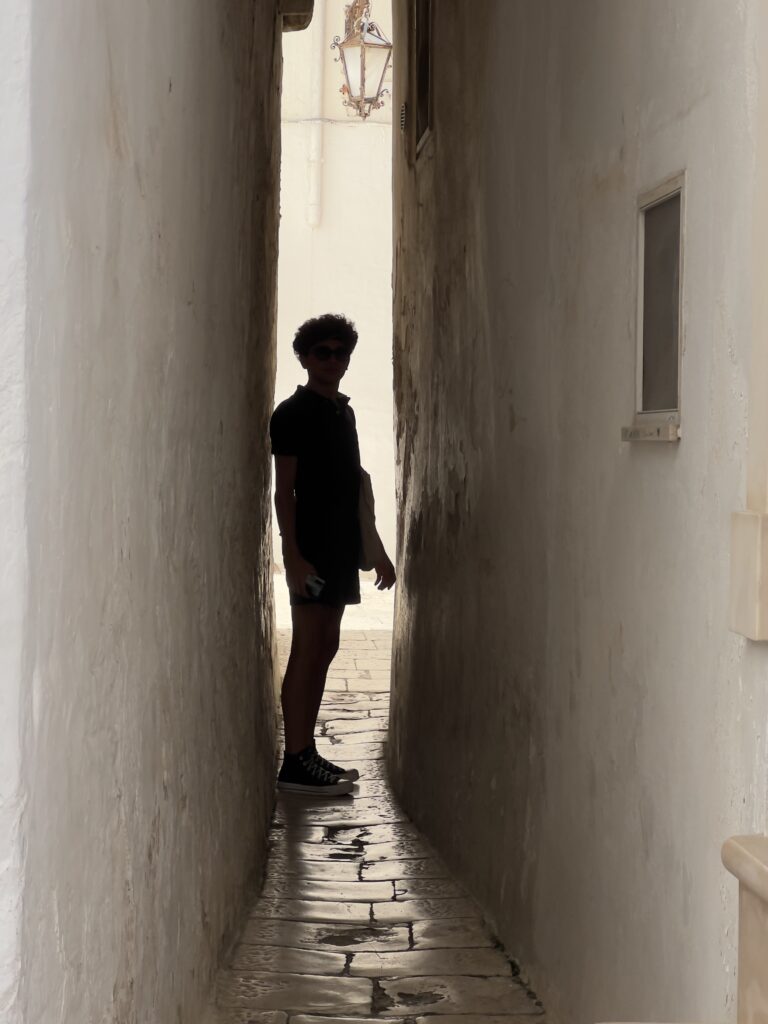
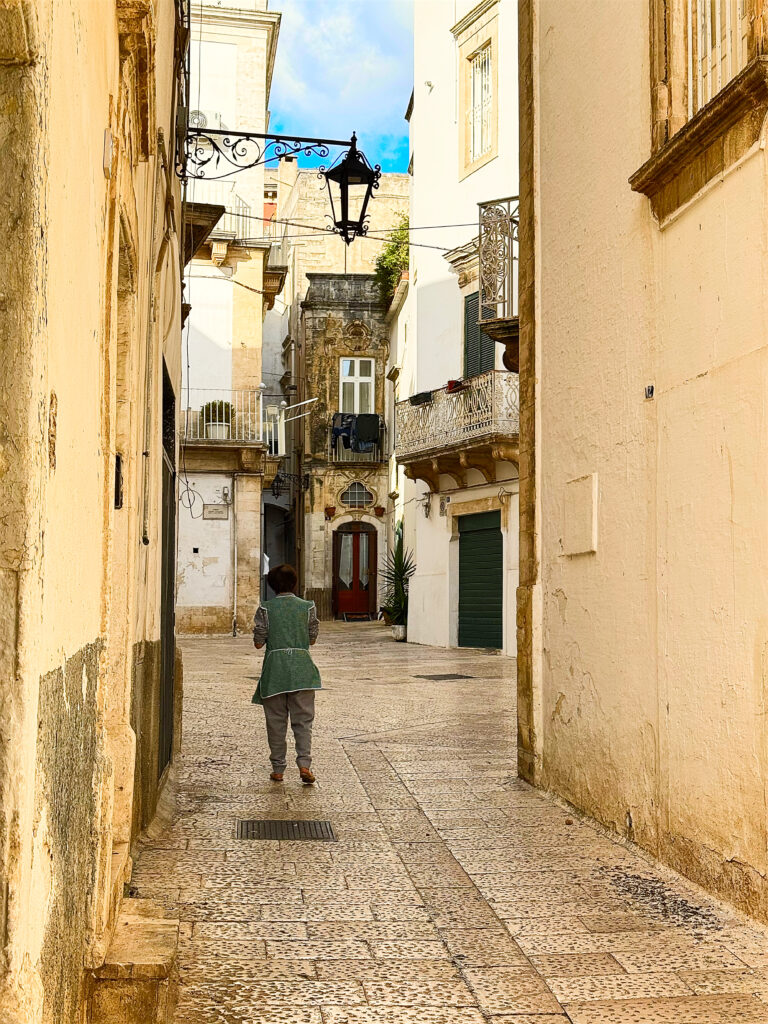
Panoramic Views & Religious Art at Villa del Carmine
Heading towards Villa del Carmine, for some greenery. Next door is the Chiesa Parrocchiale della Madonna del Carmine, known for its polychrome marble altar crafted by Neapolitan artisans and a 17th-century Crucifix by Vespasiano Genoini.
Final Stops: Piazza Mario Pagano & Via Mazzini’s Elegant Palaces
From Via Donizetti, you’ll reach Piazza Mario Pagano, where Parrocchia San Francesco d’Assisi (1685) stands, known for its rich Baroque altars and another Crucifix by Genoini.
Re-entering the historic center through Porta San Nicola, you’ll find a series of 18th-century palaces on Via Mazzini including:
- Palazzo Gioia
- Palazzo Marinosci
- Palazzo Barnaba
Nearby, is the Chiesa di San Vito dei Greci. At the end of Via Mazzini continue to the Cappella di San Nicola in , marking the entrance to Via Montedoro, one of the town’s oldest districts.
🔍 Puglia Guys Insider Tip:
- The Secret Wine Cellars of Via Montedoro – Some of the palazzi still contain underground wine storage rooms, remnants of a time when local families produced their own Primitivo and Negroamaro wines. Find them if you can!
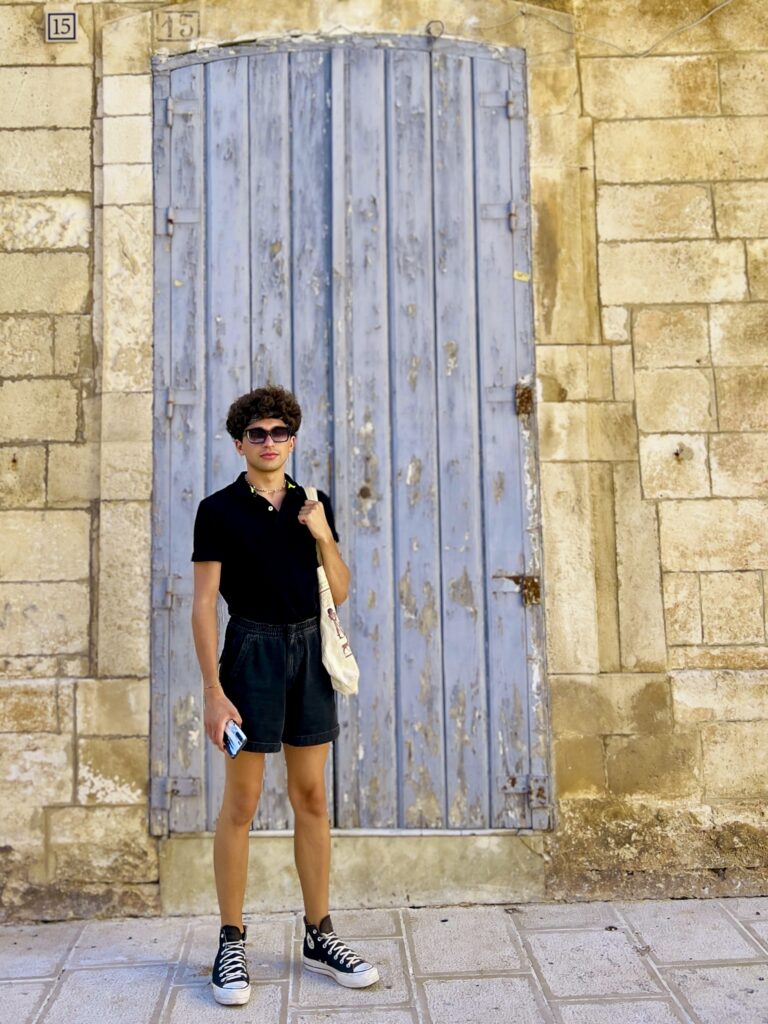
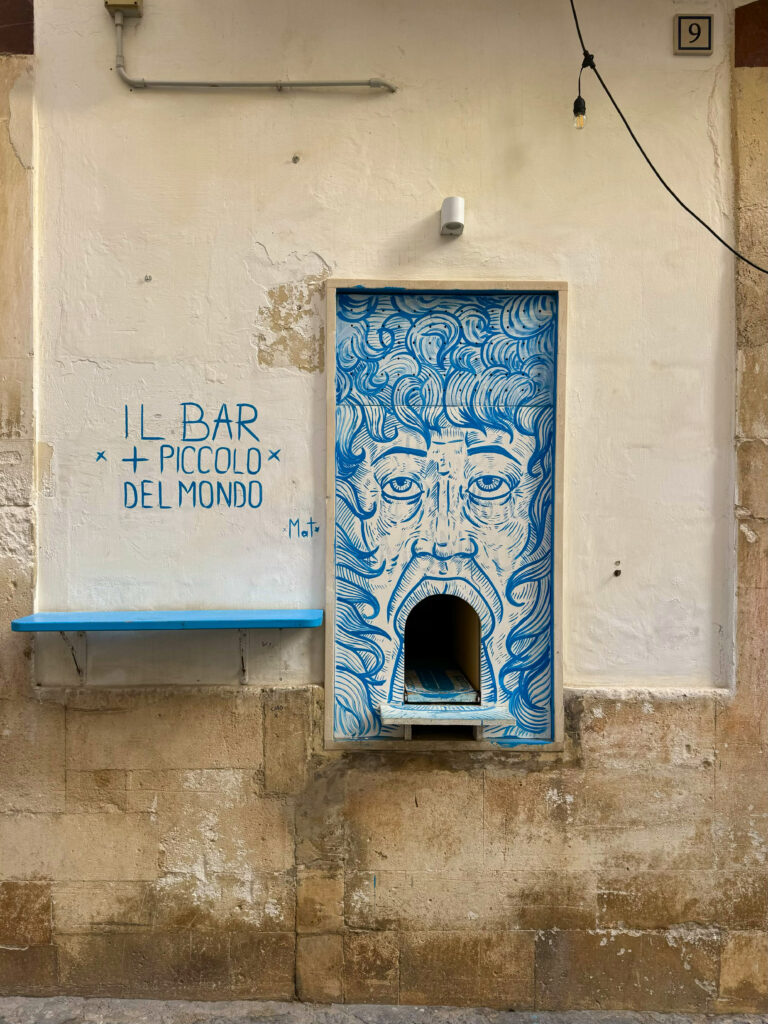
Martina Franca Guide | A Deeper Dive
Palazzo Ducale
Martina’s Palazzo Ducale stands as a remarkable blend of history, architecture, and culture, offering visitors an immersive journey through the artistic and political evolution of Martina Franca. Whether attending a festival, admiring Baroque frescoes, or exploring its noble history, the palace remains a vital cultural hub in Puglia.
OPENING HOURS:
Monday to Sunday between 10:00 – 12:00 and 17:00 – 19:00.
Admission to the halls is free (but there is a charge to access the royal apartments with their rococo murals and Murano glass chandeliers).
Guided tours are available every half hour at the following times:
🔹 Morning: 10:00 / 10:30 / 11:00 / 11:30 (last entry)
🔹 Afternoon: 17:00 / 17:30 / 18:00 / 18:30 (last entry)
For information and bookings, contact the comune of Martina Franca by email or WhatsApp:
📞 +39 3485109524
📧 palazzoducalemartinaf@gmail.com
Introduction & Historical Significance
Palazzo Ducale is a reminder of the influence of the Caracciolo duchy. Built in 1668 by Petracone V Caracciolo, at a cost of 60,000 ducati (equivalent to around 10.1 million euro) the palace replaced an earlier medieval castle (1388) constructed for Raimondo Orsini del Balzo, a powerful nobleman of the time.
Architectural Evolution
Originally a fortress, the medieval structure featured a central keep and four defensive towers. The palace’s reconstruction under Petracone V was carried out by Giovanni Andrea Carducci, an architect originally from Bergamo but at the time a longtime resident of Martina, with input from Gianlorenzo Bernini, a renowned figure in Baroque architecture. The façade showcases late-Mannerist influences, marked by a rhythmic interplay of vertical and horizontal elements reminiscent of grand Roman palaces.
The main entrance is framed by Tuscan-order semi-columns, and the façade is decorated with panoplies (military motifs), symbolizing the duchy’s power. A wrought-iron balcony crafted by 18th-century artisans wraps around the building, aligning with the ornately frescoed Gallery by Domenico Carella in the late 18th century.
Unfinished Vision & Later Modifications
Petracone V initially envisioned a U-shaped palace with gardens and fountains, but financial constraints halted construction. By 1700, only the ground floor and mezzanine were completed, with the iron balustrade added to the main façade. Further construction took place under Francesco III Caracciolo (1773), who added the eastern wing in Baroque style, as indicated by an inscription on the side balcony. The western wing was built in the 19th century, and the final wing closing off the courtyard was added in the 20th century. These phases of development are visible in the stylistic differences of the internal facades.
Palazzo Ducale Today
By the early 20th century, the Caracciolo-De Sangro family began selling off the palace. In 1928, a significant portion became Martina Franca’s City Hall, while other sections were privately acquired. Today, Palazzo Ducale houses:
- Municipal offices
- The Court House
- Isidoro Chirulli Municipal Library
- Paolo Grassi Artistic and Musical Centre
The palace is also home to major cultural events:
- Festival della Valle d’Itria (since 1974), an internationally acclaimed opera festival held in the palace atrium.
- Festival del Cabaret (since 2000), hosted on the last weekend of August.
Hall of the Dukes & Ducal Chapel
Many rooms retain their 18th-century tempera frescoes, though some are occupied by municipal offices and not open to the public. Key areas accessible to visitors include the Gallery Rooms, painted in 1776 by Domenico Carella, showcasing themes of Arcadia, Myth, and the Bible.
Upon entering via the grand staircase, visitors reach:
- The City Council Chamber, once the Ballroom, featuring a Lecce Baroque portal with twisted columns and military panoplies.
- D’Avalos Wing, built by Francesco III Caracciolo for his mother, Isabella D’Avalos.
- The Hall of the Dukes, displaying 17th-century portraits of Caracciolo rulers, adorned with Latin inscriptions and an elaborate ceiling with floral and zoomorphic motifs.
Caracciolo Legacy
The Caracciolo family, originating from Buccino, held the Duke of Martina title from 1507 until 1806, when feudalism was abolished. The family’s lineage ended in 1827 with Petracone VIII, leading to the union of the Caracciolo and De Sangro families. The last heir, Riccardo de Sangro, passed away in 1978, donating the Caracciolo-De Sangro archive to the city, now preserved in the Municipal Library.
The Gallery’s Rococo-style doors, adorned with gold leaf, shells, and volutes, provide access to further artistic rooms, highlighting the palace’s rich heritage.
Martina Franca Guide | Exploring the Chiesa di Sant’Antonio da Padova: A Journey Through History and Art
Originally built in the late 15th century by the Franciscan Observants, the church was initially dedicated to Saint Mary of Grace. It stood outside the city walls in a place once known as Saint Stephen. By 1599, the monastery was transferred to the Reformed Minor Friars, another Franciscan branch, who remained there until the 1866 post-unification suppression of religious orders. In the late 19th century, the church was rededicated to Sant’Antonio da Padova (Saint Anthony of Padua), the title it holds today.
Architectural Evolution: From Gothic to Neoclassical
The church and its adjoining convent were originally constructed in the late Gothic style, but over the centuries, they underwent significant Baroque and 19th-century Neoclassical modifications. One of the most striking renovations was the 1835 reconstruction of the façade in the Neoclassical style. The façade features four pilasters, a triangular pediment, and an asymmetrical extension on the left due to a 18th-century nave expansion. A niche with a Madonna statue and a commemorative plaque marks the church’s elevation to parish status in 1959.
To the right of the church, the former Franciscan convent features a separate entrance and once included a cemetery in what is now the Public Garden. The friars played a key role in the community, providing charitable burial services, which led to the formation of the Confraternity of the Immaculate Conception in 1570. The convent’s cloister, partially adorned with 18th-century frescoes, preserves scenes from the life of Saint Francis of Assisi and depictions of local patron saints, Saint Martin and Saint Comasia, alongside Saint Anthony of Padua.
A Walk Through the Church’s Interior
Inside, the three-naved church is marked by massive stone columns supporting pointed Gothic arches, adorned with acanthus leaves and lion-head capitals. These are the only surviving late-Gothic elements, as later modifications in the 18th and 19th centuries altered the original medieval symmetry. A 1835 renovation introduced stone vaults, an ambulatory, a raised floor, and a semicircular apse, covering earlier wooden furnishings.
The Left Nave: A Treasure Trove of Devotional Art
Look for the following highlights:
- A 19th-century painting of the Deposition
- A wooden sculpture of Saint Joseph with the Infant Jesus
- A polychrome wooden Crucifix by Friar Angelo Pietrafitta (17th century)
- Baroque altar with a 17th-century painting of the Immaculate Conception
- 1518 polychrome stone statue of Saint Stephen the Protomartyr by Stefano da Putignano
- An intricately carved wooden altar featuring Saint Paschal Baylon
The main altar, completely rebuilt in the 19th century, houses the magnificent painting Madonna of Grace with Saints (1736) by Leonardo Antonio Olivieri, depicting Franciscan saints including Saint Clare, Saint Lucy, and Saint Bonaventure. A commemorative plaque in the presbytery marks the burial site of Friar Vito of Martina Franca, a revered figure known for his miraculous works.
The Right Nave: A Glimpse of Medieval Origins
Unlike the left nave, the right nave retains more of its medieval character, evident in its vaulted ribs and remnants of wall frescoes. Notable artworks include:
- An 18th-century painting of the Holy Family’s flight to Egypt with Saint Felix of Cantalice
- A 1518 stone statue of Saint Anthony of Padua, also by Stefano da Putignano
- 16th-century fresco fragments depicting Saint Catherine of Alexandria and Saint Lawrence
- An 18th-century painting of Saint Francis receiving the Assisi Pardon
The Confraternity of the Immaculate Conception
At the far end of the convent’s cloister lies the Oratory of the Confraternity of the Immaculate Conception, officially recognised in 1710. The oratory holds:
- A 1693 wooden statue of the Immaculate Conception by Neapolitan sculptor Nicola Fumo
- Two 18th-century paintings:
- The Immaculate Conception with Saints Joachim, Anne, and the Infant Jesus by Leonardo Antonio Olivieri
- Saint Elizabeth of Hungary crowned by the Virgin, painted by Sister Maria Gesù Martucci in 1754
The confraternity members wear a traditional blue mozzetta and play a vital role in local religious celebrations.
Festivals and Accessibility
The Chiesa di Sant’Antonio da Padova remains an important religious and cultural landmark, hosting two major annual events:
- 13th June – Feast and Procession of Saint Anthony of Padua
- 8th December – Feast and Procession of the Immaculate Conception
Visitors will find the church and convent easily accessible via a ramp on the right-hand side of the building.
Martina Franca Guide | The Basilica of San Martino: A Rococo Masterpiece in Martina Franca
The Basilica of San Martino is an architectural and artistic treasure that embodies the elegance of the Rococo style. Dedicated to the town’s patron saint, Saint Martin of Tours, this basilica is not only a symbol of faith but also a testament to centuries of artistic evolution.
A Historic Journey Through Time
The site of the basilica has been a place of worship for centuries, with three successive churches standing in this location. The first, a modest pre-Angevin structure, gave way to a larger Romanesque church in the medieval period. However, following the earthquake of 1743 and the growing influence of Rococo architecture, the decision was made to construct a new basilica.
On May 5, 1747, under the leadership of Archpriest Isidoro Chirulli, construction of the current basilica began. Originally designed by Giovanni Mariani, an engineer from Bergamo, the project was completed by Giuseppe Morgese after Mariani’s passing. Notably, the basilica was built gradually, allowing religious services to continue throughout the construction.
A Striking Rococo Façade
Standing 37 meters high and 24 meters wide, the basilica’s façade is a stunning example of 18th-century craftsmanship. Made from local limestone, it is divided into two levels, accentuated by elegant pilasters and intricate sculptural details.
One of the most striking features is the high-relief sculpture of Saint Martin, depicted in the act of cutting his cloak in half to share with a beggar. The dramatic movement of the rearing horse and flowing garments adds a sense of dynamism, making it a standout piece of religious art.
Below this relief, the main entrance portal is framed by a broken tympanum, supported by statues of female figures. Surrounding the entrance are niches housing statues of saints, including Saint Joseph, Saint Paul, Saint Peter, and Saint John the Baptist. Above them, additional niches hold Saint Comasia and Saint Martina, alongside a faux papal balcony, a broken pediment, and the coat of arms of the Bishop of Tours.
Exterior Details and the Bell Tower
While the façade is highly ornate, the rest of the exterior remains relatively simple. Two side entrances—one to the north and another to the south—feature inscriptions honoring Saint Martin’s protection over the town during plagues, famines, and natural disasters.
Along the southern side, grotesque gargoyles with expressive faces can be seen high above, adding a unique touch to the basilica’s design. Nearby, the late Romanesque bell tower tells another chapter of the basilica’s history. Once taller, it was shortened in 1768 after sustaining damage from earthquakes and lightning, though it still retains its medieval decorative elements.
A Grand and Elegant Interior
Stepping inside, visitors are greeted by an interior that epitomizes the splendor of Rococo design. The Latin cross layout and single nave are enriched with elaborate stucco decorations, towering pilasters, and grand side chapels.
At the heart of the basilica is the high altar, an exquisite piece adorned with polychrome marble and gilded accents. Above it, the fresco of the Glory of Saint Martin, painted by Domenico Carella, captures the saint’s heavenly ascension, surrounded by angels and other divine figures.
Among the many chapels, two stand out:
- The Chapel of Saint Comasia, which houses a revered 18th-century statue of the co-patroness of the town.
- The Chapel of Our Lady of Sorrows, featuring an emotionally powerful sculpture of the Virgin Mary, attributed to Neapolitan artist Giuseppe Sanmartino.
The basilica also boasts a rich collection of sacred relics, silver processional crosses, chalices, and vestments, reflecting the town’s deep devotion and historical wealth.
A Place of Living Faith and Cultural Heritage
After nearly three decades of construction, the Basilica of San Martino was officially consecrated on October 22, 1775. Over the centuries, it has remained a central place of worship, culminating in its elevation to Minor Basilica status by Pope John Paul II in 1998.
Martina Franca Guide | Exploring the Chiesa del Monte Purgatorio
Founded in 1649, the Chiesa del Monte Purgatorio (Church of Monte del Purgatorio) was dedicated to the Virgin of Grace of Monte and originally built to house the Confraternity of Priests.
Like many churches associated with religious brotherhoods, Monte del Purgatorio features two distinct levels. The lower floor is a place of religious worship, while the upper floor served as an oratory for members of the confraternity. The church’s baroque façade, adorned with intricate reliefs and Latin inscriptions, hints at the spiritual significance and artistic richness that lie within.
The Exterior: A Blend of History and Symbolism
Visitors entering the church from Via Vittorio Emanuele will notice the secondary portal, which bears an engraved inscription that dates the church to 1649:
“VOS, ANIMAE CLAMANT, SALTEM, MISERAE SCITE, FRATRES, 1649”
(The suffering souls cry out to you for help—know this, O brothers, 1649).
Although the secondary entrance is modestly framed, the window above it, now walled up, showcases an elegant arched design with a cherub at the keystone, while the architrave features decorative rosettes reminiscent of Renaissance ornamentation. The bell tower, which rises above the structure, adds to the church’s striking silhouette.
Turning the corner onto Via Cirillo, visitors are met with the main façade, where a carved lunette above the entrance depicts the Souls of Purgatory, a central theme of the church. Another Latin inscription reinforces the church’s message of faith and redemption:
“UT CRUCIAT POENAE, CHARITAS SIC URGEAT OES”
(As suffering brings torment, so too should charity move all).
Above the entrance, a rounded niche shelters a delicate painting of the Madonna and Child, flanked by two elegant single-light windows, adding symmetry and grace to the façade.
The Interior: A Masterpiece of Baroque Art
Stepping inside, visitors are immediately enveloped in a visually stunning interior, where baroque artistry and trompe-l’œil effects create a space of immense beauty and depth. The rectangular nave is entirely adorned with faux marble paintings, a technique that enhances the richness of the space.
The ceiling, painted in tempera, mimics a coffered vault, with a stunning arrangement of octagonal and square panels, each decorated with delicate rose motifs at its centre. Surrounding this grand ceiling are additional allegorical paintings, depicting the Virtues and the Souls of Purgatory, immersed in dramatic flames.
One of the church’s artistic highlights is a painting by Giovanni Caramia, a renowned 17th-century painter from Martina Franca. His Saint Michael the Archangel with the Souls in Purgatory is an intense and highly theatrical composition, featuring luminous colours and dynamic figures that seem to come to life on the canvas. This piece, located within an elaborate baroque setting, captivates viewers with its emotional depth and dramatic intensity.
The high altar, crafted in the Baroque style, is crowned by a statue of the Blessed Virgin of Grace, a 17th-century stone sculpture that serves as the church’s spiritual focal point.
The Upper Floor: An Oratory of Heavenly Illusions
Ascending to the upper level, visitors would have once entered the oratory of the Confraternity of Priests, an extraordinary space where art and perspective merge to create an ethereal atmosphere. The wooden ceiling, covered in 17th-century painted canvases, is a masterpiece of trompe-l’œil illusion.
The ceiling depicts a balustrade with bulbous columns, stretching across all four sides of the oratory, creating the illusion of a suspended balcony when viewed from below. Adding to this dreamlike effect, cherubs appear to move along the balustrade, some carrying garlands of flowers, while others hold small framed paintings of the Souls in Purgatory. The deep blue background further enhances the illusion, making the scene feel almost celestial.
At the centre of the ceiling, within an ornate frame, is a breathtaking depiction of the Deposition of Christ from the Cross, an artwork that embodies the emotional intensity and religious fervour of the Baroque period.
Practical Information
📍 Location: Via Cirillo, 1
🚪 Access: At the time of writing the church is currently closed to the public.
Martina Franca Guide | San Domenico Church: A Church Reborn
The current Church of San Domenico is the second to stand on this site. The original medieval church, dedicated to Saint Peter Martyr, suffered severe damage during the 1743 earthquake. Rather than restoring it, the local community decided to completely rebuild the structure in a new and more elaborate style. Construction began on 23 May 1745 and was completed by 1753.
The project was led by Fra Antonio Cantalupi, a Dominican friar, and executed by two master builders: Calmerio del Vecchio and Michele Cito. The former, a native of Lecce, played a significant role in introducing the ornate Lecce Baroque style to Martina Franca. His influence is evident in the church’s decorative motifs, which closely resemble the flamboyant façades of Lecce’s historic buildings.
The church’s dimensions—36 metres long, 13 metres wide, and 18 metres high—reflect the urban constraints of its location. While the façade is not exceptionally tall, it compensates with an elaborate sculptural design, making it one of the most visually striking landmarks in the city.
A Façade of Sculptural Splendour
The façade of San Domenico is a stunning example of Baroque extravagance, marked by a rich interplay of sculptural elements and symbolic motifs. The design follows a two-tiered structure, where decorative pilasters and ornate carvings create a sense of movement and grandeur.
Key features of the façade include:
- A lavishly decorated entrance portal, framed by elegant curved volutes topped with cherubs blowing trumpets.
- The Dominican Order’s emblem—a dog holding a flaming torch, symbolising the spreading of faith—prominently displayed above the entrance.
- Anthropomorphic capitals featuring winged sirens, acanthus leaves, and pomegranate garlands, inspired by the 17th-century Palazzo del Seminario in Lecce.
- A highly elaborate curvilinear window, framed with sculpted scrolls and acanthus leaves, topped by a cherub flanked by decorative volutes. This feature replaces the traditional rose window or papal balcony, making it a unique element of 18th-century architecture.
- A broken and curled pediment at the very top, adding to the church’s dramatic Baroque aesthetics.
Step Inside: A Journey Through Art and Devotion
While the façade is a spectacle in itself, the interior of San Domenico is equally splendid. The Baroque detailing continues inside, with finely carved stucco decorations, intricate altarpieces, and painted frescoes that adorn the nave and chapels. Visitors can admire:
- The main altar, an exquisite masterpiece of marble and gilded detailing.
- Side chapels housing sacred relics, religious paintings, and sculptures, each narrating a different chapter of Martina Franca’s spiritual history.
- The elaborate ceiling frescoes, depicting scenes of faith and divine intervention in the true Baroque style.
The church remains an active place of worship, where local devotees gather for prayer, religious festivals, and traditional processions.
Visitor Information
📍 Location: Via Principe Umberto, Martina Franca, Italy
🕰 Opening Hours:
- Morning: 7:30 AM – 12:30 PM
- Afternoon/Evening: 4:30 PM – 8:30 PM
♿ Accessibility: A ramp located in the adjacent convent provides easy access to the church’s interior.
Martina Franca Guide | The Baroque Beauty of Chiesa del Carmine in Martina Franca
The Church’s Fascinating History
The story of Chiesa del Carmine dates back to 1614, when the Carmelite Order established a convent outside the city walls, replacing a pre-existing chapel dedicated to the Madonna della Misericordia. Over the centuries, the convent underwent several transformations, even serving as a maternal and child care institution during the Fascist period. In 1727, Frate Pietro Tommaso Carbotti initiated the reconstruction of the church, culminating in its present form around 1758.
Architectural Highlights
The Baroque façade of Chiesa del Carmine is an architectural masterpiece. Influenced by Borromini’s Roman designs, the exterior features curved and broken pediments, decorative volutes, and dynamic sculptural elements. Scholars suggest that Mauro Manieri, a renowned architect from Lecce trained in Rome, may have designed the church, as its façade closely resembles both the Oratorio dei Filippini in Rome and San Cataldo in Taranto.
Key architectural elements include:
- A grand façade divided into two sections, enriched with pilasters, niches, and statues.
- A simple yet elegant entrance portal, topped by a sculpted mandorla with an image of the Madonna del Carmine.
- A bell tower with a lantern, offering a striking silhouette against the Puglian sky.
A Walk Through the Church’s Interior
Stepping inside, visitors are greeted by a Latin cross layout with a single nave, adorned with intricate stucco decorations, frescoes, and altars crafted from local stone and polychrome marble.
Key interior highlights include:
- The main altar (1759), featuring a stunning painting of the Madonna del Carmelo with Saints Simone Stock, Elijah, and Elisha by Pietro Cataldo Mauro.
- Side chapels, including the Chapel of the Madonna della Libera, which houses a 1660 painting by Giovanni Stefano Caramia.
- The richly decorated dome, adorned with 19th-century stuccoes, trompe-l’œil effects, and sculptures of the Four Evangelists.
- The sacristy, furnished with 1773 walnut cabinets and housing Renaissance-era religious artwork.
The Church’s Cultural and Spiritual Role
After the departure of the Liguorini Fathers in 1886, the church’s Confraternity of Monte Carmelo took over its care, preserving its historical and artistic treasures. The Statue of the Madonna del Carmine, known as La Scapigliata, is the centrepiece of religious processions, especially during the annual Feast of Our Lady of Mount Carmel.
Visitor Information
- Address: Via Pergolesi, Martina Franca, Italy
- Opening Hours: 7:30 AM – 12:30 PM | 4:30 PM – 8:30 PM
- Accessibility: The church is easily accessible to all visitors.
Martina Franca Guide | Exploring the Chiesa di San Francesco d’Assisi in Martina Franca: A Hidden Baroque Gem
A Rich History Rooted in Franciscan Tradition
The Church of St. Francis of Assisi was built by the Franciscan Conventual Order in the late 17th century. The Conventual Franciscans, commonly known as the “Black Franciscans,” first arrived in Martina Franca towards the end of the 1600s. They were granted permission to build a new place of worship near Porta di San Nicola, replacing an earlier convent that had been destroyed. The church and adjoining convent took decades to complete, with construction spanning from 1680 to 1728. Skilled Lecce stone artisans meticulously crafted the interiors, adorning the church with elaborate Baroque altars.
A Striking Facade with Baroque Influences
Although partially reconstructed in the 19th century after a devastating hurricane in 1852, the church’s facade maintains its elegant symmetry and classical proportions. Featuring slender pilasters, sculpted volutes, and intricate relief work, the exterior showcases the refined yet restrained Baroque style. The main entrance is particularly impressive, flanked by fluted columns and crowned with a statue of the Immaculate Virgin, protector of the Franciscan Order.
A Baroque Masterpiece Within
Step inside, and you’ll be mesmerised by the richly decorated interiors that contrast with the church’s relatively simple exterior.
At the heart of the church’s artistic legacy are its eight side altars, each a masterpiece of intricate stone carving, gilded ornamentation, and religious symbolism. These altars, sculpted by skilled artisans from Lecce, showcase the Baroque obsession with movement, contrast, and theatricality.
The Left Side of the Nave: Devotion and Theatrical Beauty
The Altar of the Pardon of Assisi (1710)
- Commissioned by the Motolese family, this altar is crowned with their coat of arms (three oak trees with birds).
- The altarpiece, painted by an anonymous 18th-century artist, depicts the Virgin Mary appearing to St. Francis on August 2, 1216, granting him the famous Pardon of Assisi.
- The altar is adorned with twisted Solomonic columns, delicate carvings, and a sculptural ensemble featuring St. Bernardine of Siena (left) and St. Clare of Assisi (right). Above, the figures of St. Peter of Alcantara and St. Paschal Baylón stand in quiet reverence.
The Altar of St. Joseph (1724)
- Built by Count Palatine Pietro Antonio Barnaba, this altar is dedicated to St. Joseph, depicted in a painted stone sculpture set within a niche.
- The upper section features St. Peter the Apostle and St. Anthony of Padua, likely chosen as the patron saints of the count himself.
The Altar of the Crucifix
- One of the most moving altars in the church, this one houses a 18th-century painting of Christ on the Cross.
- Flanking the painting, the figures of St. Mary Magdalene and St. Veronica bear witness to Christ’s suffering, while the upper tier is adorned with St. Vitus and St. Cyrus the Martyr, alongside a painted representation of the Holy Face of Christ.
- A particularly striking feature is the glass-enclosed sculpture of the Dead Christ, placed beneath the altar for veneration.
The Altar of the Immaculate Conception
- This altar, attributed to the painter Nicola Gliri (a 17th-century artist from Bitonto), showcases a painting of the Immaculate Virgin, framed by elaborate scrollwork and gilded details.
- Commissioned by Marsilia Fullone, a wealthy patron of the church, the altar bears her family crest—a shield with a bundle of lilies, symbolizing purity and Marian devotion.
The Right Side of the Nave: Artistic Splendour and Spiritual Symbolism
The Altar of St. Francis of Assisi
- This altar features an 18th-century polychrome statue of St. Francis, set within a grand, sculpted frame.
- Two allegorical figures sit atop the altar’s broken pediment: the Synagogue (left), symbolizing the Old Testament, and the Church (right), cradling a lamb, representing the Passion of Christ.
- The lower section features a bas-relief of St. Francis assisting souls in Purgatory, framed by a seashell-shaped niche supported by angels and floral motifs.
The Altar of St. Anthony of Padua
- A highlight of the church, this altar features a finely sculpted painted stone statue of St. Anthony, standing on a pedestal adorned with cherub faces.
- Surrounding him are four small statues of virgin martyrs: St. Barbara and St. Agatha on the left, and St. Apollonia and St. Lucy on the right.
- Above, a stone cross stands between St. Nicholas (left) and St. Oronzo (right), forming a tableau of divine protection and intercession.
- Recent restoration work has revealed the original vibrant colors of this altar, previously hidden under layers of white paint.
The Altar of St. Philip Neri
- This altar features a painted stone sculpture of St. Philip Neri, a 16th-century saint known for his joyful approach to faith.
- The flanking statues depict St. Roch (left) and Blessed Andrew Conti (right), while above, St. John the Baptist takes center stage, accompanied by St. Bonaventure of Bagnoregio and King Louis IX of France.
The Altar of St. Michael the Archangel
- The final altar on the right side houses a 1763 painting by Pietro Cataldo De Mauro, depicting St. Michael defeating the forces of darkness.
- Statues of St. Elizabeth of Hungary (left) and St. Rose of Viterbo (right) add to the devotional richness of this grand composition.
The High Altar: A Monumental Tribute to the Eucharist
At the centre of the sanctuary, the main altar dominates the space with its monumental sculptural presence.
- Dedicated to the Blessed Sacrament, it features a realistic, life-sized crucifix, attributed to the Venetian sculptor Giacomo Colombo, a renowned artist active in Naples during the late 17th and early 18th centuries.
- The altar’s ornate tabernacle, surrounded by gilded angels and intricate relief work, underscores the importance of the Eucharist in Franciscan spirituality.
Hidden Artistic Discoveries and Architectural Secrets
Recent restoration projects have unveiled fascinating insights into the church’s original colour scheme and ceiling structure.
- The coffered ceiling, now painted in a muted brown, was originally adorned with floral motifs and gold accents, echoing the decorative style of the Baroque period.
- The original open-beam ceiling was later replaced by an octagonal coffered vault in 1880, further enhancing the grandeur of the space.
A Sanctuary of Spiritual and Cultural Significance
The church is not just a place of worship but also a sanctuary of Christ in Agony, drawing pilgrims and visitors alike. The Procession of the Mysteries, an annual event dating back to 1716, brings the church to life during Holy Week, as lifelike papier-mâché statues depicting Christ’s Passion are carried through the town.
The Convent: A Place of Community and Service
The adjacent convent, originally built for Franciscan friars, has served various purposes over the centuries. Following the Napoleonic suppression of religious orders in 1809, the building was repurposed as a hospital, orphanage, and later a retirement home. Today, part of the convent houses municipal offices, while another section remains a hub for the Brotherhood of St. Anthony of Padua, a religious community with deep historical roots.
Artistic Discoveries and Hidden Treasures
Recent restoration efforts have uncovered vibrant original polychrome decorations beneath layers of whitewash, offering a glimpse into the church’s opulent Baroque past. The coffered ceiling, originally featuring octagonal panels with floral motifs, hints at the lavish artistic traditions once embraced by the Franciscan friars.
Martina Franca Guide | San Vito: A Medieval Gem with Baroque Elegance
One of the oldest churches in Martina Franca, San Vito dates back to the early 14th century, soon after the town’s foundation by Philip of Anjou. Its original entrance on Largo Ciaia features a stylised fleur-de-lis, a clear symbol of its Angevin origins.
Despite its medieval roots, the 18th-century renovations gave the church a Baroque interior, with elaborate decorations and ornate altars. The most striking feature is the stone statue of Saint Vito, commissioned in 1779 by a generous local patron, Pietro Simeone. Depicting the saint with a small dog at his feet, the statue remains a focal point of devotion.
San Vito is also linked to an intriguing historical event: in 1645, it temporarily safeguarded the relics of Saint Comasia, the co-patron saint of Martina Franca, after a sudden storm disrupted their ceremonial transfer. Since then, Saint Comasia has been associated with rain, and her relics are still carried in processions during times of drought.
📍 Location: Largo Ciaia
🚪 Open to Visitors: Yes, accessible via Via Mazzini
Martina Franca Guide | San Nicola in Montedoro: A Testament to Time
Tucked away on Via Cristoforo Colombo, San Nicola in Montedoro has a fascinating past. Originally built as San Paolo dei Greci in the 14th century, the church later fell into ruin before being rebuilt in the 17th century. Over time, it took on different names, reflecting its roles as both a place of worship and a charitable institution.
The church’s exterior retains several late medieval features, including:
- A Gothic ogival portal
- A lunette niche
- A small radial rose window
- A single-arched bell gable
Inside, the church boasts an impressive collection of frescoes, spanning from the 16th to the 19th century. The central fresco, depicting the Madonna delle Grazie with Saint Nicholas and other saints, was restored in 1802 by Francesco Carella, son of the renowned artist Domenico Carella. Other notable frescoes include:
- The Pietà
- Saint Anthony the Abbot
- The Madonna of the Rosary, surrounded by medallions illustrating scenes from Christ’s life
- The Massacre of the Innocents
Although many frescoes have been repainted or partially lost, the church still exudes an ancient, spiritual atmosphere, making it a must-visit for art lovers and history enthusiasts.
📍 Location: Via Cristoforo Colombo
🚪 Open to Visitors: Rarely open to the public.
